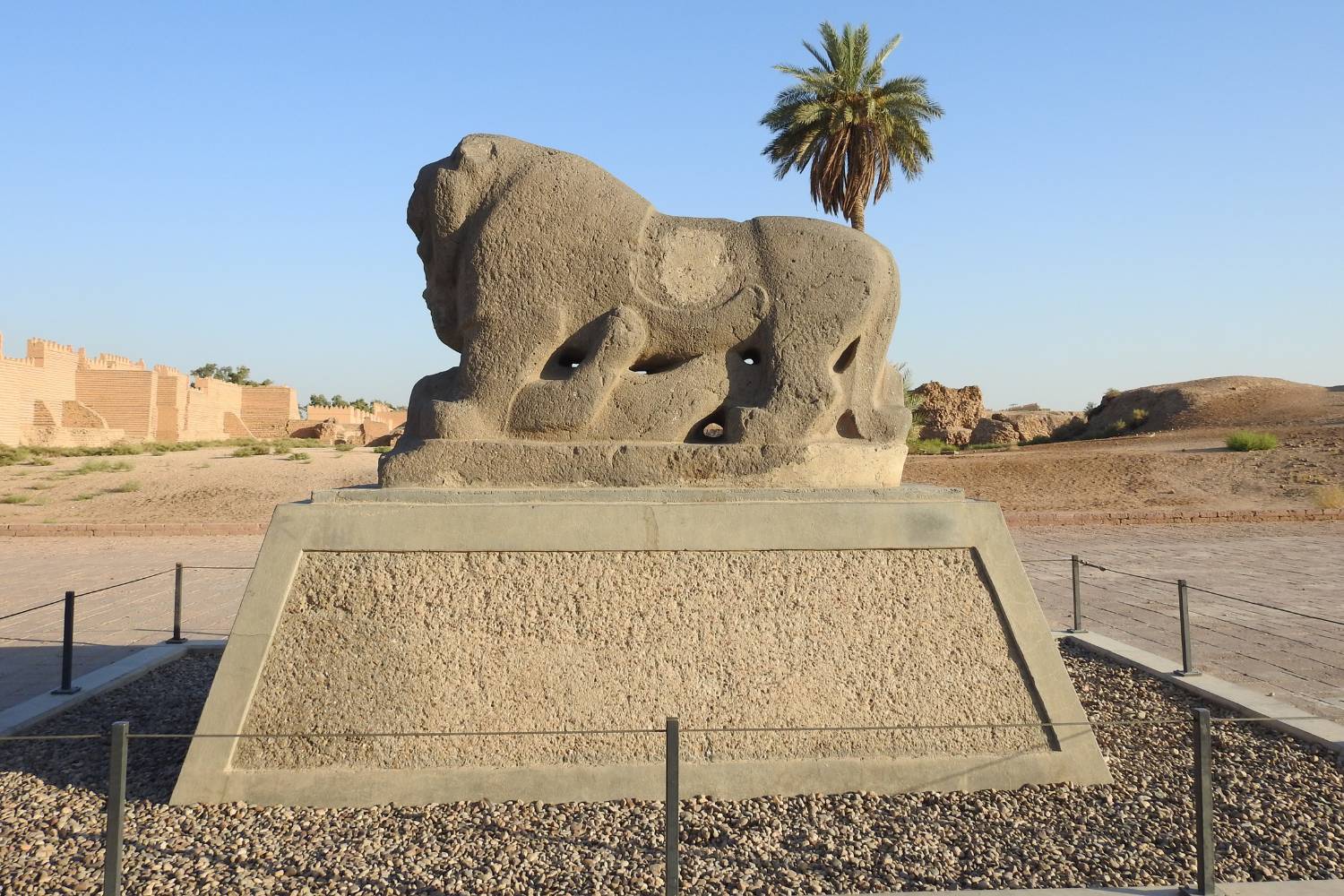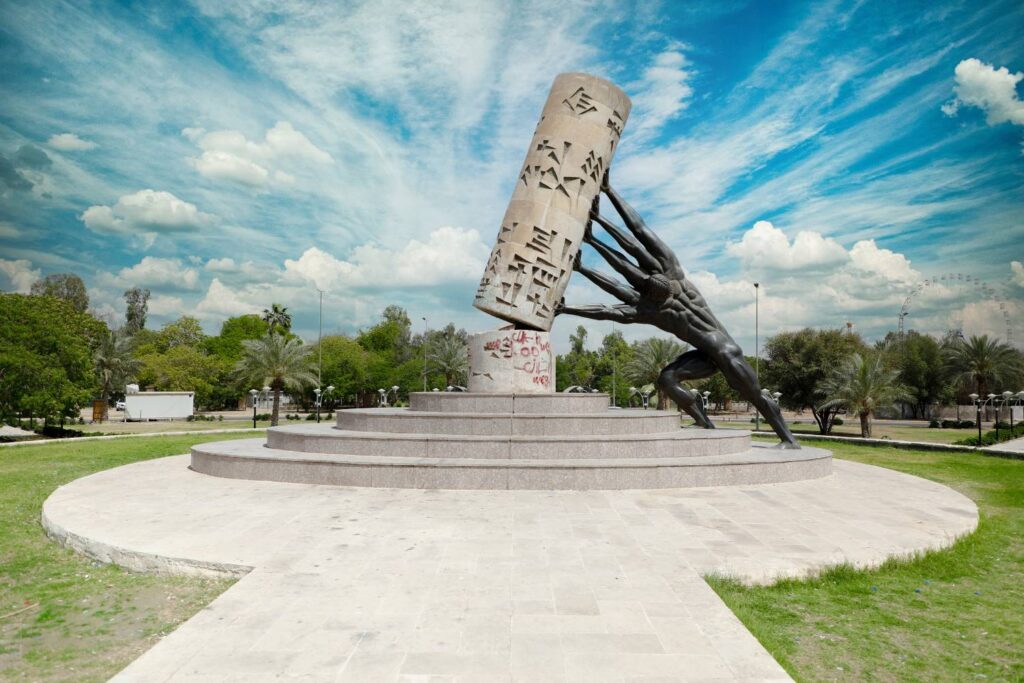Iraq, often referred to as the cradle of civilization, boasts a rich and diverse cultural heritage that spans thousands of years. Situated in the heart of the ancient Mesopotamian region, Iraq culture has been influenced to some of the earliest known civilizations, including the Sumerians, Akkadians, Babylonians, and Assyrians. This long and varied history has left a profound impact on the country’s cultural landscape, influencing its art, music, literature, architecture, and daily life.
Historical Culture of Iraq

The history of the culture of Iraq begins with Mesopotamia, often called the “land between rivers” due to its location between the Tigris and Euphrates. It is here that human civilization first took root around 6000 BC. The Sumerians, one of the earliest civilizations, developed cuneiform writing, one of the earliest forms of written expression, which paved the way for complex administrative systems and recorded history.
Babylon Ancient City, under the reign of King Nebuchadnezzar II, became one of the world’s great ancient cities. The legendary Hanging Gardens, considered one of the Seven Wonders of the Ancient World, exemplify the grandeur of this era. The influence of these early civilizations is still evident in contemporary Iraqi culture, which prides itself on this deep historical lineage.
Iraq Culture Chronology
Birth of Civilization in Mesopotamia (c. 3500 BC)
- Significance: Known as the “Cradle of Civilization,” Mesopotamia (modern-day Iraq) saw the emergence of some of the first human civilizations, including the Sumerians, Akkadians, Babylonians, and Assyrians.
- Cultural Impact: Innovations in writing (cuneiform), law (Code of Hammurabi), and urbanization began here, forming the bedrock of modern civilization.
Development of Cuneiform Writing (c. 3400 BC)
- Significance: The Sumerians developed one of the earliest writing systems, cuneiform, which was used for recording laws, trade, and stories.
- Cultural Impact: This innovation facilitated the documentation and transmission of knowledge, culture, and administration.
The Epic of Gilgamesh (c. 2100 BC)
- Significance: One of the earliest known works of literary fiction, this Sumerian epic explores themes of heroism, friendship, and the quest for immortality.
- Cultural Impact: It remains a cornerstone of literary heritage and reflects early human concerns and storytelling traditions.
Babylonian Empire and the Code of Hammurabi (c. 1754 BC)
- Significance: King Hammurabi of Babylon established one of the earliest and most comprehensive law codes.
- Cultural Impact: This code influenced legal systems in the region and underscored the importance of law and order in society.
Rise of the Assyrian Empire (c. 900–612 BC)
- Significance: The Assyrians were known for their military prowess, extensive libraries, and monumental architecture.
- Cultural Impact: Assyrian culture influenced art, architecture, and administration in the region, leaving a legacy of impressive archaeological sites.
Islamic Golden Age and the Abbasid Caliphate (8th–13th centuries AD)
- Significance: Baghdad became the intellectual and cultural heart of the Islamic world, fostering advancements in science, literature, and philosophy.
- Cultural Impact: Contributions from this period include the development of algebra, astronomy, medicine, and a rich literary tradition.
- Significance: Iraq was part of the Ottoman Empire for nearly four centuries, influencing its administrative structures, trade, and cultural practices.
- Cultural Impact: Ottoman architectural styles, cuisine, and legal systems left a lasting imprint on Iraqi culture.
Formation of Modern Iraq (1920)
- Significance: After the fall of the Ottoman Empire, Iraq was established as a modern state under British mandate and gained independence in 1932.
- Cultural Impact: This period saw the establishment of modern political institutions and the blending of traditional and contemporary cultural elements.
- Significance: This devastating conflict had profound social, economic, and political effects on Iraq and its people.
- Cultural Impact: The war influenced Iraqi literature, art, and public consciousness, reflecting themes of loss, resilience, and patriotism.
Fall of Saddam Hussein and the Iraq War (2003–2011)
- Significance: The US-led invasion in 2003 led to the toppling of Saddam Hussein’s regime and ushered in a period of significant political and social upheaval.
- Cultural Impact: The subsequent instability and reconstruction efforts have deeply affected Iraqi society, influencing contemporary art, literature, and cultural identity.
Languages in Iraq
Arabic is the official language of Iraq, with Kurdish also widely spoken in the Kurdistan region.
Here’s a comprehensive table about the languages spoken in Iraq, including the ethnic groups that speak them, the approximate number of speakers, and other relevant details:
| Language | Ethnic Group(s) | Approximate Number of Speakers | Key Regions | Additional Information |
|---|---|---|---|---|
| Arabic | Arabs, various ethnic groups | 30-32 million | Nationwide | Official language of Iraq; used in government, education, media |
| Kurdish (Sorani) | Kurds | 6-7 million | Kurdistan Region (Erbil, Sulaymaniyah, Dohuk) | One of the official languages in the Kurdistan Region of Iraq |
| Kurdish (Kurmanji) | Kurds | 2-3 million | Northern Iraq | Predominantly spoken by Kurds in Dohuk and parts of Nineveh |
| Turkmen | Turkmen | 500,000 – 800,000 | Kirkuk, Tuz Khurmatu, Erbil | The third most widely spoken language in Iraq |
| Neo-Aramaic (Assyrian) | Assyrians | 200,000 – 300,000 | Northern Iraq, especially in Nineveh Plains | One of the oldest continuously spoken languages in the region |
| Neo-Aramaic (Chaldean) | Chaldeans | 100,000 – 150,000 | Baghdad, Nineveh Plains | A dialect of Neo-Aramaic spoken by Chaldean Christians |
| Armenian | Armenians | 10,000 – 20,000 | Baghdad, Basra | Spoken by the Armenian community, mostly in urban areas |
| Persian (Farsi) | Various ethnic groups | Few thousand | Border regions near Iran | Limited to small communities, especially near the Iran-Iraq border |
| Shabaki | Shabak | 200,000 | Northern Iraq, especially in Nineveh Plains | Related to Kurdish and Persian languages, spoken by the Shabak community |
| Mandaic | Mandaeans | Less than 5,000 | Baghdad, Basra | An endangered language spoken by the Mandaean community |
Music in Iraq
Iraqi music is a blend of traditional and modern influences, incorporating instruments like the oud (a type of lute), qanun (a stringed instrument), and ney (a type of flute). The maqam, a traditional form of Arabic music, holds a significant place in Iraqi culture. It is characterized by a set of scales and melodic patterns that evoke specific moods and emotions.
Here’s an interesting table about the music of Iraq, detailing its various forms, historical origins, notable musicians, and where you can experience it:
| Music Form | Date of Origin | Cultural Origins | Notable Musicians | Where to Experience It |
|---|---|---|---|---|
| Iraqi Maqam | 9th century AD | Arabic, Mesopotamian | Munir Bashir, Hussein Al-Azami | Various cultural centers, Baghdad |
| Chobi (Dabke) Dance Music | Ancient | Kurdish, Arab, Assyrian | Traditional ensembles | Weddings, festivals across Iraq |
| Contemporary Iraqi Pop | 20th century | Modern Iraqi | Kadim Al Sahir, Rahma Riad | Concerts, radio, TV, online platforms |
| Kurdish Folk Music | Ancient | Kurdish | Ali Merdan, Shahram Nazeri | Erbil, Sulaymaniyah |
| Traditional Bedouin Music | Ancient | Bedouin | Traditional tribal musicians | Western deserts, cultural festivals |
| Assyrian Music | Ancient | Assyrian | Linda George, Ashur Bet Sargis | Assyrian communities, churches |
| Turkmen Music | Ancient | Turkmen | Various local artists | Kirkuk, Turkmen regions |
| Iraqi Classical Music | 20th century | Modern Iraqi, Western | Baghdad Symphony Orchestra | Baghdad National Theatre, cultural events |
| Religious Chanting (Nasheed) | 7th century AD | Islamic | Various religious leaders | Mosques, religious gatherings |
| Iraqi Jazz | 20th century | Modern Iraqi | Ilham al-Madfai | Cafes, music festivals, Baghdad |
Dance in Iraq
Dance is also an integral part of Iraqi culture, with traditional folk dances like the Chobi being performed at weddings and celebrations. The Chobi involves rhythmic movements and steps, often accompanied by live music, and showcases the communal spirit and joy of Iraqi festivities.
Here’s an engaging table about the various forms of dance in Iraq, including their cultural origins, characteristics, notable performers, and where they can be seen:
| Dance Form | Cultural Origins | Characteristics | Notable Performers/Groups | Where to Experience It |
|---|---|---|---|---|
| Chobi (Dabke) | Arab, Kurdish, Assyrian | Circle dance, stomping, rhythmic clapping | Traditional ensembles | Weddings, festivals across Iraq |
| Kurdish Halparke | Kurdish | Line dance, holding hands, vibrant movements | Various Kurdish dance troupes | Erbil, Sulaymaniyah |
| Assyrian Khigga | Assyrian | Circle dance, hand-holding, foot stomping | Assyrian dance groups | Assyrian communities, cultural events |
| Baghdadi Kawliya (Gypsy) Dance | Romani (Kawliya) | Energetic, expressive, acrobatic movements | Kawliya dancers, Hayfaa al-Hajjar | Cultural festivals, performances in Baghdad |
| Turkmen Folklore Dance | Turkmen | Traditional attire, coordinated group movements | Various local artists | Kirkuk, Turkmen regions |
| Yazidi Sacred Dance | Yazidi | Spiritual, ceremonial, performed during religious rituals | Yazidi community members | Lalish, Yazidi festivals |
| Sufi Whirling | Islamic (Sufi) | Mystical, spinning movements, spiritual | Sufi orders, dervishes | Mosques, Sufi gatherings |
| Arab Bedouin Dance | Bedouin | Traditional, tribal, sword dance variants | Bedouin tribes | Western deserts, Bedouin gatherings |
| Iraqi Ballet | Modern Iraqi, Western | Classical ballet, modern choreography | Baghdad Ballet School, National troupe | Baghdad National Theatre, cultural events |
| Children’s Folk Dance | Various ethnic groups | Simple, playful, often educational | School groups, local dance clubs | Schools, community events, festivals |
Art in Iraq
Iraq’s artistic heritage is deeply rooted in its ancient past. Mesopotamian art, known for its intricate carvings, sculptures, and pottery, set the foundation for later artistic expressions. The use of ziggurats, large temple complexes, is a distinctive feature of ancient Mesopotamian architecture, reflecting the spiritual and societal structures of the time.
Islamic art and architecture have also left a significant mark on Iraq. The Abbasid Caliphate, with Baghdad as its capital, was a golden age of Islamic culture. The city was adorned with grand mosques, palaces, and libraries. The Great Mosque of Samarra, with its iconic spiral minaret, is a testament to the architectural ingenuity of this period.
In contemporary times, Iraqi artists continue to draw inspiration from their rich heritage while addressing modern themes. The Iraqi art scene has produced renowned artists like Jewad Selim, who played a pivotal role in modern Arab art.
Here’s a table highlighting some unique forms of art that were either created or developed in Iraq, including their date of creation, cultural origins, notable figures, and locations where they can be viewed:
| Art Form | Date of Creation | Cultural Origins | Famous People | Where to See It |
|---|---|---|---|---|
| Cuneiform Writing | c. 3400 BC | Sumerians, Mesopotamians | Iraq Museum, Baghdad | |
| Ziggurat Architecture | c. 2100 BC | Sumerians, Akkadians | Ziggurat of Ur, Nasiriyah | |
| Epic of Gilgamesh | c. 2100 BC | Sumerians, Akkadians | Iraq Museum, Baghdad | |
| Ishtar Gate | c. 575 BC | Babylonians | King Nebuchadnezzar II | Pergamon Museum, Berlin (original) |
| Mesopotamian Cylinder Seals | c. 3500 BC | Sumerians, Akkadians | British Museum, London; Iraq Museum, Baghdad | |
| Abbasid Architecture | 8th-13th centuries AD | Abbasid Caliphate | Al-Mustansiriya School, Baghdad | |
| Iraqi Maqam Music | Developed 13th century | Arabic | Munir Bashir, Naseer Shamma | Various cultural centers in Baghdad |
| Baghdad School of Miniature Painting | 12th-13th centuries AD | Arabic | Yahya ibn Mahmud al-Wasiti | Various museums, private collections |
| Modern Iraqi Art Movement | 20th century | Modern Iraqi artists | Jewad Selim, Shakir Hassan Al Said | Iraqi Museum of Modern Art, Baghdad |
| Jewad Selim’s Monument to the Unknown Soldier | 1959 | Modern Iraqi | Jewad Selim | Baghdad |
Save Iraqi Culture Monument
The Save Iraqi Culture Monument in Baghdad is a important symbol dedicated to the preservation and resilience of Iraq’s rich cultural heritage amidst decades of conflict and turmoil. Erected in the wake of widespread destruction and looting that plagued the country, particularly following the Iraq War in 2003, this monument stands as a testament to the enduring spirit of the Iraqi people and their unwavering commitment to safeguarding their historical and cultural identity.

Historical Context: Iraq, known as the cradle of civilization, has faced extensive cultural and archaeological losses due to war, looting, and neglect. The invasion of 2003 and the subsequent instability led to the plundering of museums, libraries, and historical sites, causing an irreplaceable loss of ancient artifacts and manuscripts.
Structure: The Save Iraqi Culture Monument features a broken and crumbling cylindrical stone column, symbolizing the damaged state of Iraq’s cultural heritage. Surrounding the column are sculpted hands and arms, reaching out in support. This imagery represents the collective effort of the Iraqi people and the global community to prevent the collapse of their cultural identity.
Celebrations in Iraq
Iraq celebrates a variety of religious and cultural festivals that reflect its diverse population. Islamic holidays such as Eid al-Fitr and Eid al-Adha are widely celebrated, marked by communal prayers, feasts, and charity. Ashura, particularly significant for Shia Muslims, commemorates the martyrdom of Imam Hussein and involves processions and reenactments.
Nowruz, the Persian New Year, is celebrated in the Kurdistan region with festivities that include traditional music, dance, and feasts. This spring festival symbolizes renewal and the arrival of the new year according to the Persian calendar.
Here’s a table of major festivals and celebrations in Iraq, detailing the time of year, number of people celebrating, specific communities involved, and approximate historical origins:
| Festival/Celebration | Time of Year | People Celebrating | Community | Approximate Origin |
|---|---|---|---|---|
| Eid al-Fitr | End of Ramadan (variable) | 38-40 million | Sunni and Shia Muslims | 7th Century AD |
| Eid al-Adha | 10th day of Dhu al-Hijjah (variable) | 38-40 million | Sunni and Shia Muslims | 7th Century AD |
| Ashura | 10th day of Muharram (variable) | 20-24 million | Shia Muslims | 7th Century AD |
| Arbaeen | 40 days after Ashura | 20-24 million | Shia Muslims | 7th Century AD |
| Nowruz | March 21st | 6-8 million | Kurdish, Persian, others | Over 3000 years ago |
| Mawlid al-Nabi | 12th Rabi’ al-awwal (variable) | 38-40 million | Sunni and Shia Muslims | 8th Century AD |
| Ramadan | 9th month of Islamic calendar (variable) | 38-40 million | Sunni and Shia Muslims | 7th Century AD |
| Newroz | March 21st | 6-8 million | Kurdish, Persian, others | Over 3000 years ago |
| Christmas | December 25th | 250,000-400,000 | Christians | 1st Century AD |
| Yazidi New Year | April (variable) | 500,000-700,000 | Yazidis | Ancient Mesopotamian |
| Sarbast | August 15th | 500,000-700,000 | Yazidis | Ancient Mesopotamian |
| Eid al-Ghadir | 18th Dhu al-Hijjah (variable) | 20-24 million | Shia Muslims | 7th Century AD |
| Shab-e-Barat | 15th Sha’ban (variable) | 38-40 million | Sunni and Shia Muslims | 8th Century AD |
| Kurdish Independence Day | March 11th | 6-8 million | Kurdish | 20th Century AD |
| Chaharshanbe Suri | Last Wednesday of the year (Iranian calendar) | 6-8 million | Kurdish, Persian, others | Ancient Zoroastrianism |
Food in Iraq
Iraqi cuisine is a rich tapestry of flavors and dishes that reflect the country’s diverse cultural influences. Staples include rice, lamb, and a variety of vegetables and legumes. Popular dishes like biryani, kebabs, and dolma (stuffed grape leaves) are often seasoned with aromatic spices such as cumin, coriander, and saffron.
A traditional Iraqi meal often includes mezze (small appetizers), a main course, and desserts like baklava and dates. Tea and coffee are integral to Iraqi hospitality, often served during social gatherings.
Here’s a table of the top 10 most important dishes in Iraq, including their name, region, major influences, main ingredients, and the best city to eat them:
| Dish Name | Region | Major Influences | Main Ingredients | Best City to Eat |
|---|---|---|---|---|
| Masgouf | Nationwide | Mesopotamian | River fish (carp), tamarind, olive oil | Baghdad |
| Kubba | Nationwide | Middle Eastern, Kurdish | Bulgur, minced meat, onions, spices | Mosul |
| Dolma | Nationwide | Ottoman, Persian | Grape leaves, rice, minced meat, vegetables | Baghdad, Erbil |
| Kleicha | Nationwide | Middle Eastern | Date paste, flour, cardamom | Basra |
| Tashreeb | Nationwide | Arabic, Ottoman | Lamb, chickpeas, broth, bread | Najaf |
| Samak Masgouf | Southern Iraq | Mesopotamian | Grilled fish, tomatoes, lemon | Basra |
| Biryani | Nationwide | Indian, Persian | Rice, meat, vegetables, spices | Baghdad |
| Quzi | Nationwide | Persian, Middle Eastern | Lamb, rice, nuts, raisins | Baghdad |
| Bagila Bil Dihin | Southern Iraq | Arabic | Rice, fava beans, lamb fat, spices | Basra |
| Kubbah Mosul | Northern Iraq | Kurdish, Middle Eastern | Bulgur, minced meat, spices, onions | Mosul |
Religion in Iraq
Islam is the predominant religion in Iraq, with Shia and Sunni Muslims making up the majority of the population. The country is also home to other religious communities, including Christians, Yazidis, and Mandaeans. This religious diversity has contributed to Iraq’s rich spiritual landscape, with numerous mosques, churches, and temples dotting the country.
The holy cities of Najaf and Karbala are significant pilgrimage sites for Shia Muslims. Najaf is home to the Imam Ali Shrine, while Karbala hosts the Imam Hussein Shrine, both drawing millions of pilgrims annually.
Table detailing the religions present in Iraq, including approximate dates of their introduction to the country, the number of adherents, and their most important cities, highlighting the rich background of faiths that coexist within the country’s borders.
| Religion | Date of Entrance | Estimated Followers | Most Important Cities |
|---|---|---|---|
| Shia Islam | 7th Century AD | 20-24 million | Najaf, Karbala |
| Sunni Islam | 7th Century AD | 14-18 million | Baghdad, Mosul |
| Christianity | 1st Century AD | 250,000 – 400,000 | Mosul, Erbil, Baghdad |
| Yazidism | 2nd Century AD | 500,000 – 700,000 | Lalish (Shekhan District) |
| Mandaeism | 1st Century AD | 5,000 – 10,000 | Basra |
| Zoroastrianism | 6th Century BC | 5,000 – 10,000 | Kurdistan (Yazd historically) |
| Shabakism | 14th Century AD | 150,000 – 200,000 | Mosul |
| Sabeanism | 1st Century AD | Few thousand | Najaf |
| Judaism | 6th Century BC | Historically significant, now minimal | Baghdad, Kurdistan |
| Bahá’í Faith | 19th Century AD | Few hundred | Baghdad, Basra |
Conclusion
Iraq’s culture is a vibrant mosaic of ancient traditions and modern influences, reflecting its historical depth and contemporary dynamism. From its early civilizations to its current artistic and literary contributions, Iraq remains a land of profound cultural richness. Exploring Iraq’s cultural heritage offers a unique glimpse into the heart of a nation that has shaped, and continues to shape, human history.


